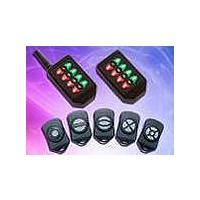OTX-418-HH-LR8-HS Linx Technologies Inc, OTX-418-HH-LR8-HS Datasheet - Page 3

OTX-418-HH-LR8-HS
Manufacturer Part Number
OTX-418-HH-LR8-HS
Description
XMITTER HS LNG-RANGE 418MHZ 8BTN
Manufacturer
Linx Technologies Inc
Datasheet
1.OTX-315-HH-LR8-HS.pdf
(7 pages)
Specifications of OTX-418-HH-LR8-HS
Function
Transmitter, OOK
Frequency
418MHz
Interface
Handheld, 8 Button
Voltage - Supply
2.1 V ~ 3.6 V
Board Size
106.3 mm x 41.1 mm x 15.2 mm
Minimum Operating Temperature
- 40 C
Supply Voltage (min)
2.1 V
Product
RF Modules
Maximum Frequency
418 MHz
Supply Voltage (max)
3.6 V
Maximum Operating Temperature
+ 85 C
Lead Free Status / RoHS Status
Lead free / RoHS Compliant
Features
-
Power - Output
-
Applications
-
Sensitivity
-
Data Rate - Maximum
-
Modulation Or Protocol
-
Lead Free Status / Rohs Status
Lead free / RoHS Compliant
TYPICAL SYSTEM SETUP
Page 4
1. Create and exchange a key from a decoder to the handheld transmitter
2. Establish Control Permissions
The HS Series Long-Range Handheld Transmitter is intended to make user
setup straightforward while ensuring the highest possible security. This inherent
ease of use can be illustrated by a typical user setup. The Typical Applications
section of the HS Series Decoder Data Guide shows the circuit schematics on
which the receiver examples are based.
The handheld transmitter includes an on-
board infrared receiver designed to
optically receive the decoder’s key
transmission. Sending the key in this
manner preserves security while avoiding
the need for a hardwire connection.
The high security key is created and
exchanged by placing the decoder in the
Create
MODE_IND LED will light to indicate that
the decoder has entered Create Key
Mode. The decoder’s CREATE_KEY
button is then pressed ten times to create
the key. After the tenth press, the MODE_IND LED will turn off and the decoder
will output the key via a 900nm infrared diode on the KEY_OUT line. A paper clip
is used to press the GET_KEY button on the back of the transmitter. Hold the
back of the transmitter near the decoder’s infrared diode within twenty seconds.
Once the key has been transferred, the MODE_IND LEDs on the transmitter and
decoder illuminate to indicate success.
Next, the user defines which buttons on the transmitter will be acknowledged by
the decoder. The HS Series Control Permissions allow each transmitter in a
system to activate different data lines. This is especially useful in applications
where differing user access or activation capabilities are desired.
Consider this practical example: a three-door garage houses Dad’s Corvette,
Mom’s Mercedes, and Son’s Yugo. With most competitive products, any user’s
keyfob could open any garage door as long as the addresses match. In an HS-
based system, the keyfobs could easily be configured to open only certain doors
(guess which one Son gets to open!).
Setting the control permissions is intuitive. The user presses the decoder’s
LEARN button. The decoder’s MODE_IND LED will start flashing and the user
simply presses the handheld transmitter buttons that will be recognized. Control
Permissions are stored when the LEARN button is pressed again or
automatically after seventeen seconds.
There are other powerful options, such as programming a user PIN or copying a
decoder, but these two steps are all that is required for a typical setup.
Key
Mode.
The
decoder’s
Figure 2: Button Access Holes
MODE_IND
Window
GET_KEY Button
CREATE_PIN
Button
USING THE OPTIONAL KEYPAD PIN
CONTENTION CONSIDERATIONS
BATTERY REPLACEMENT
Creation of a keypad PIN
1. Use a paper clip to press the CREATE_KEY button on the back of the
2. To enter the PIN, press a sequence of any four buttons. The MODE_IND will
3. To cancel Create PIN Mode prior to the fourth entry, either wait for the fifteen
4. If a new KEY is created, the PIN will be automatically erased.
Using the PIN
1. The PIN is entered by pressing each button until all four entries have been
2. Once the PIN is successfully entered, the transmitter will be operational unless
For higher security applications, the HS Series encoder has the option to set a
Personal Identification Number (PIN) to control access to the encoder. This PIN
is a four-button combination of the eight buttons which must be entered before
the transmitter will send any commands. It will need to be re-entered after fifteen
minutes of inactivity. If no PIN is created, then the transmitter will activate as
soon as a button is pressed.
It is important to understand that only one transmitter at a time can be activated
within a reception area. While the transmitted signal consists of encoded digital
data, only one carrier of any particular frequency can occupy airspace without
contention at any given time. If two transmitters are activated in the same area
at the same time, then the signals will interfere with each other and the decoder
will not see a valid transmission, so it will not take any action.
The transmitter uses a standard CR2032 lithium
button cell. In normal use, it will provide 1 to 2 years
of operation. To replace the battery, remove the
access cover by pressing firmly on the label area and
sliding it off. Once the unit is open, remove the
battery by sliding it from beneath the holder. There
may be the risk of explosion if the battery is replaced
by the wrong type. Replace it with the same type of
battery while observing the polarity shown in the
adjacent figure.
transmitter. The MODE_IND LED will begin flashing until either a PIN is
successfully entered or fifteen seconds has passed.
stop flashing and the PIN will be created.
second timeout to pass or press the CREATE_KEY button. The MODE_IND
LED will stop flashing and no PIN will be created.
made. There is a maximum two-second time limit between entries, after which
the PIN must be re-entered in its entirety.
it is inactive for fifteen minutes, in which case the PIN must be re-entered.
Figure 3: Battery Access
Battery Access
+
Page 5




















